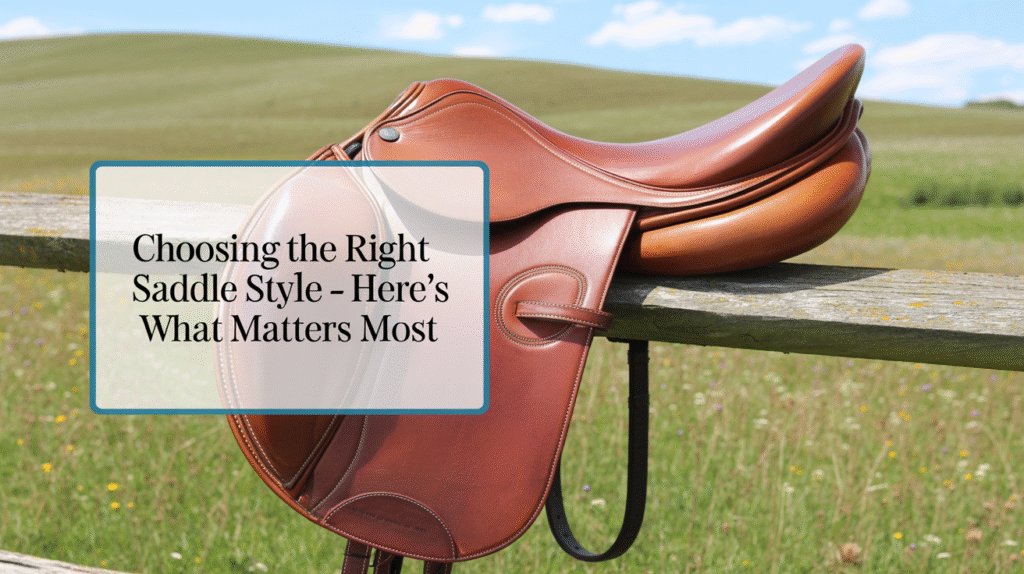Choosing the right saddle style is essential for both the rider’s comfort and the horse’s well-being. The wrong saddle can cause pain, poor posture, and long-term issues for the horse, while also making the ride uncomfortable or even unsafe for the rider. Whether you’re riding English or Western, trail riding or jumping, selecting the appropriate saddle style tailored to your riding discipline, body type, and your horse’s shape is critical.

Let’s explore how to choose the ideal saddle style and what factors influence that decision.
Understanding Saddle Types and Their Uses
Different saddle types are designed for different riding disciplines. Choosing based on your specific use case helps ensure safety and performance.
English Saddles
English saddles are commonly used for disciplines such as dressage, jumping, and eventing.
- Dressage Saddles: Deep seat with straight flaps designed to support proper leg positioning.
- Jumping Saddles: Forward-cut flaps and a flatter seat to allow the rider to move freely over jumps.
Western Saddles
Western saddles are ideal for long rides and working ranch purposes, offering greater surface area for weight distribution.
- Roping Saddles: Strong and sturdy with a reinforced tree.
- Barrel Racing Saddles: Lightweight and compact for faster turns and agility.
Factors That Influence Saddle Selection
A few key factors determine the most appropriate saddle style for both horse and rider.
Your Riding Discipline
Choose the saddle that aligns with your primary riding activity.
- Trail riding: Comfort and support for long hours in the saddle.
- Jumping: Close contact and forward cut to support jumps.
- Dressage: Deep seat for precision and balance.
Horse Conformation
The shape and build of your horse greatly influence saddle fit.
- Wither shape: High withers need more clearance to avoid pressure.
- Back length: Short-backed horses require saddles with a shorter panel length.
Rider’s Body Type and Comfort
Comfort should never be compromised. A poorly fitting saddle can cause hip or back discomfort for the rider.
- Seat size: Should accommodate your hip width comfortably.
- Flap length: Should match the length of your leg to maintain balance and control.
Key Features to Consider When Choosing a Saddle
Pay attention to these elements while selecting a saddle to ensure proper function and fit.
Saddle Tree
The internal frame of the saddle supports the rider’s weight.
- Flexible trees: Provide more comfort and adapt to movement.
- Rigid trees: Offer more support for structured activities like roping.
Seat Depth and Width
Both affect rider stability and comfort.
- Deep seats: Better for beginners or dressage riders needing security.
- Flat seats: Suitable for jumping and experienced riders.
Flap Shape and Length
The flap needs to accommodate your leg position.
- Straight flaps: Ideal for flat work or dressage.
- Forward flaps: Better for jumping disciplines.
Common Mistakes to Avoid When Choosing a Saddle
Avoid these pitfalls that could lead to discomfort or poor performance.
- Choosing by appearance: Focus on fit and function over looks.
- Ignoring professional fitting: Always consult a saddle fitter.
- Buying a ‘one-size-fits-all’ saddle: Horses and riders vary too much for this to be effective.
Tips for Testing a Saddle Before You Buy
Trying out the saddle before buying helps avoid costly mistakes.
- Ride in the saddle: See how it feels during different gaits.
- Check for pressure points: Use a saddle pad to check for even weight distribution.
- Get feedback: Ask an instructor or saddle fitter to observe your ride.
FAQs
Here are some questions and answers about choosing the right saddle style:
What is the most comfortable saddle for long trail rides?
Western trail saddles are typically the most comfortable for long rides due to their broader weight distribution and padded seats.
How do I know if a saddle fits my horse?
Look for even contact along the panels, no bridging, and at least 2-3 fingers of clearance over the withers. Your horse should move freely and show no signs of discomfort.
Can I use an English saddle for trail riding?
Yes, but it’s less ideal for very long rides. If using an English saddle, consider adding extra padding or using a model designed for endurance.
Should a beginner use a deep seat or flat seat?
Beginners benefit from deep-seated saddles as they provide more stability and security.
How often should I check my saddle fit?
Check it at least once a season or whenever your horse’s weight or muscle tone changes noticeably. Regular checks ensure long-term comfort and health.